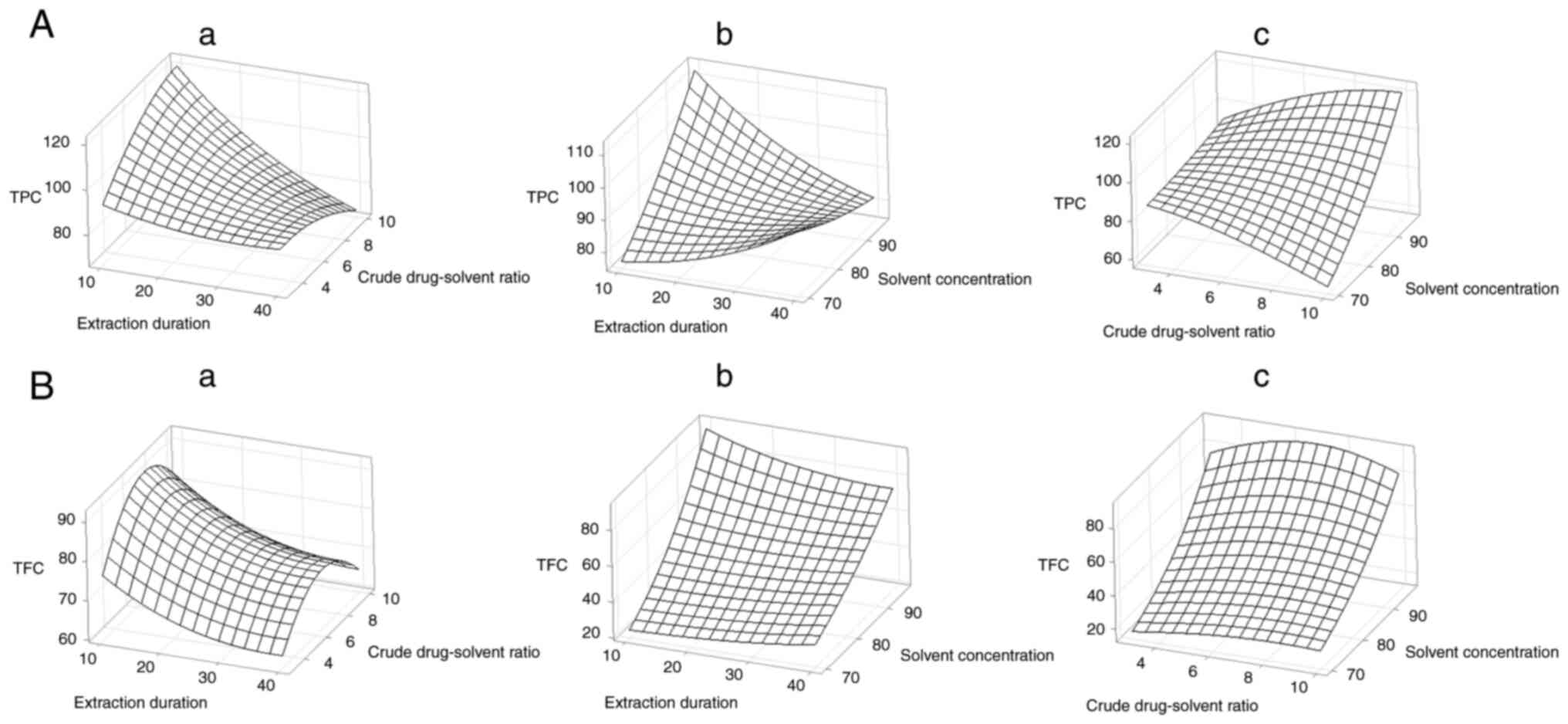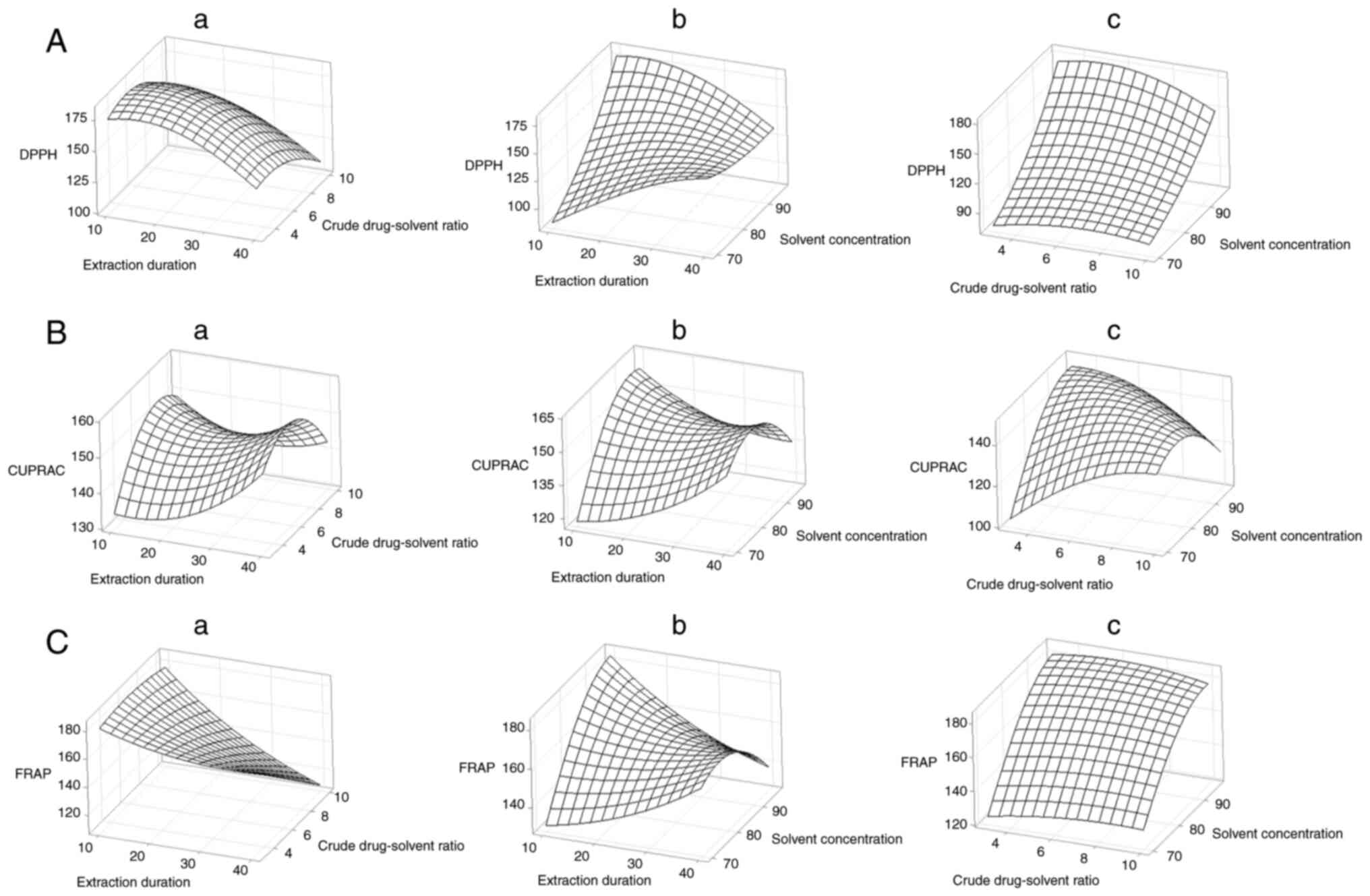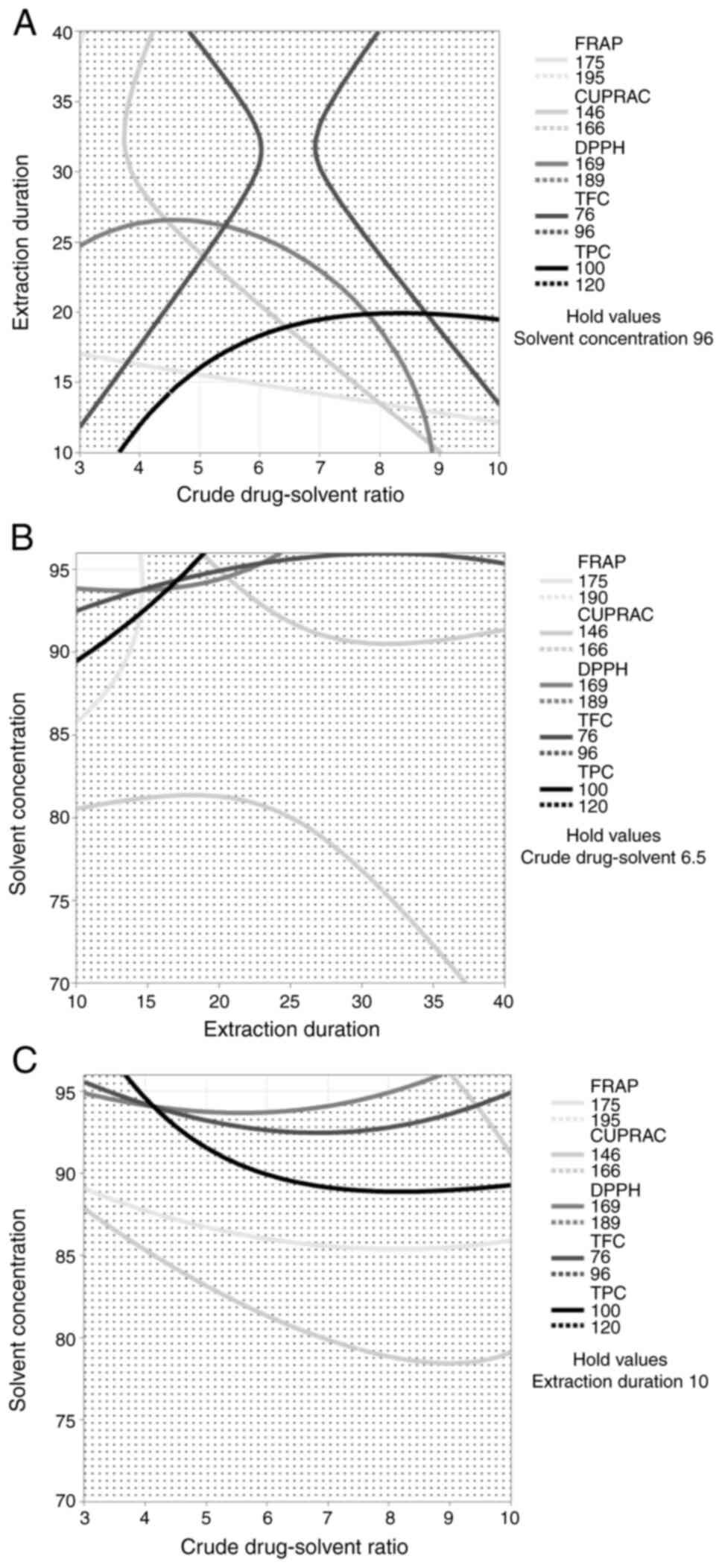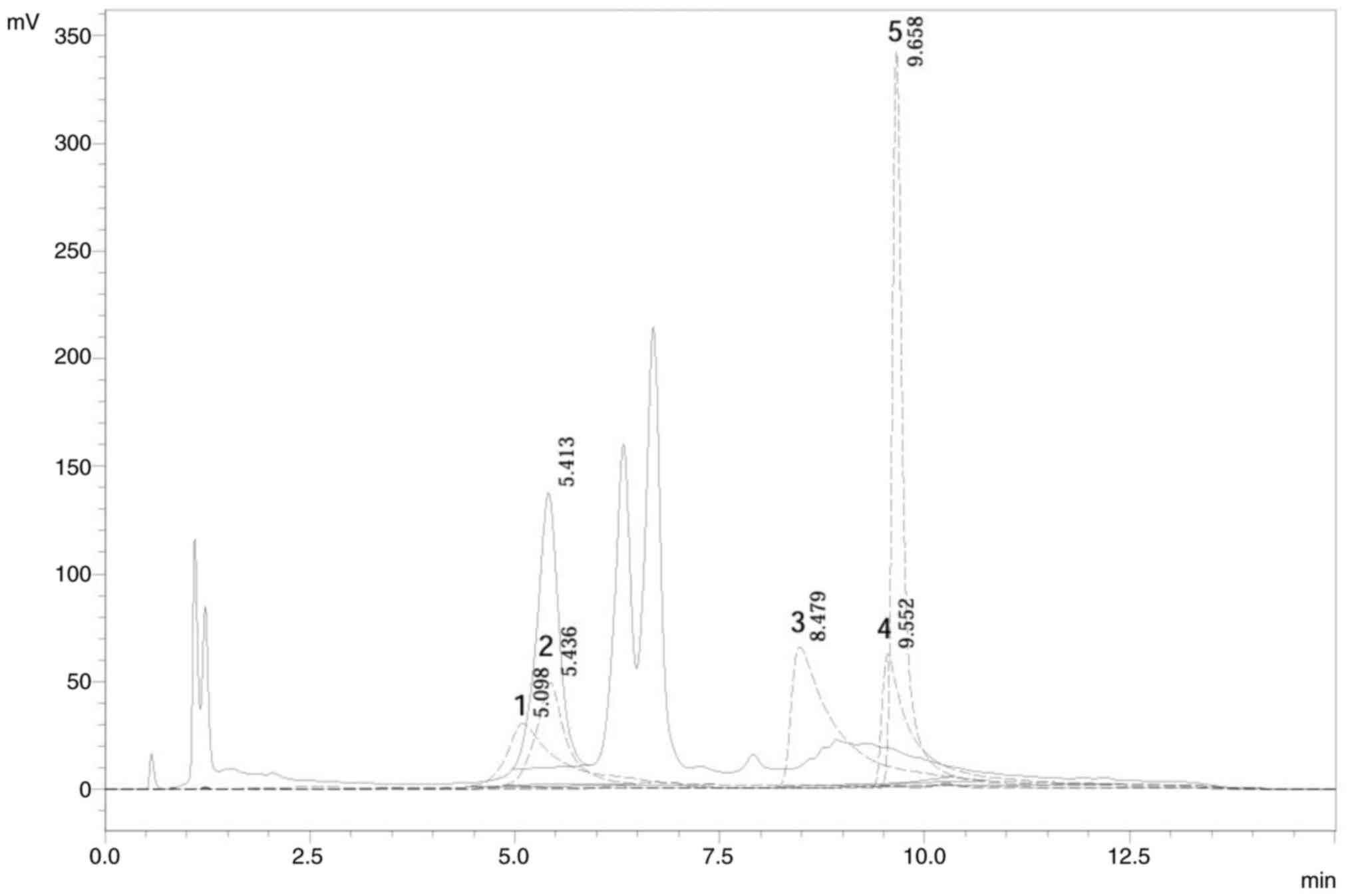|
1
|
Christodoulou MC, Orellana Palacios JC,
Hesami G, Jafarzadeh S, Lorenzo JM, Domínguez R, Moreno A and
Hadidi M: Spectrophotometric methods for measurement of antioxidant
activity in food and pharmaceuticals. Antioxidants (Basel).
11(2213)2022.PubMed/NCBI View Article : Google Scholar
|
|
2
|
Pham TN, Lam TD, Nguyen MT, Le XT, Vo DVN,
Toan TQ and Vo TS: Effect of various factors on extraction
efficiency of total anthocyanins from butterfly pea (Clitoria
ternatea L. Flowers) in Southern Vietnam. IOP Conf Ser Mater
Sci Eng. 544(012013)2019.
|
|
3
|
Mutakin M, Fauziati R, Fadhilah FN,
Zuhrotun A, Amalia R and Hadisaputri YE: Pharmacological activities
of soursop (Annona muricata Lin.). Molecules.
27(2701)2022.PubMed/NCBI View Article : Google Scholar
|
|
4
|
Kim J, Kim DG and Ryu KH: Enhancing
response surface methodology through coefficient clipping based on
prior knowledge. Processes. 11(3392)2023.
|
|
5
|
Pereira LMS, Milan TM and Tapia-Blácido
DRT: Using response surface methodology (RSM) to optimize 2G
bioethanol production: A review. Biomass Bioenergy.
151(106166)2021.
|
|
6
|
Farnsworth NR: Biological and
phytochemical screening of plants. J Pharm Sci. 55:225–276.
1966.PubMed/NCBI View Article : Google Scholar
|
|
7
|
Rowe RC, Shesky PJ and Quinn ME: Handbook
of pharmaceutical excipients. 6th edition. Pharmaceutical Press,
pp506-509, 2009.
|
|
8
|
Pourmorad F, Hosseinimehr SJ and
Shahabimajd N: Antioxidant activity, phenol and flavonoid contents
of some selected Iranian medicinal plants. Afr J Biotechnol.
5:1142–1145. 2006.
|
|
9
|
Chang CC, Yang MH, Wen HM and Chern JC:
Estimation of total flavonoid content in propolis by two
complementary colorimetric methods. J Food Drug Anal. 10:178–182.
2002.
|
|
10
|
Celep E, Charehsaz M, Akyüz S, Acar ET and
Yesilada E: Effect of in vitro gastrointestinal digestion on the
bioavailability of phenolic components and the antioxidant
potentials of some Turkish fruit wines. Food Res Int. 78:209–215.
2015.PubMed/NCBI View Article : Google Scholar
|
|
11
|
Özyürek M, Bektaşoǧlu B, Güçlü K, Güngör N
and Apak R: Simultaneous total antioxidant capacity assay of
lipophilic and hydrophilic antioxidants in the same acetone-water
solution containing 2% methyl-beta-cyclodextrin using the cupric
reducing antioxidant capacity (CUPRAC) method. Anal Chim Acta.
630:28–39. 2008.PubMed/NCBI View Article : Google Scholar
|
|
12
|
Insanu M, Zahra AA, Sabila N, Silviani V,
Haniffadli A, Rizaldy D and Fidrianny I: Phytochemical and
antioxidant profile: Cucumber pulp and leaves extracts. Open Access
Maced J Med Sci. 10:616–622. 2022.
|
|
13
|
Hasmila I, Natsir H and Soekamto NH:
Phytochemical analysis and antioxidant activity of soursop leaves
extract (Annona muricata Linn.). J Phys Conf Ser.
1341(032027)2019.
|
|
14
|
Qorina F, Arsianti A, Fithrotunnisa Q and
Tejaputri NA: Phytochemistry and antioxidant activity of soursop
(Annona muricata) leaves. Int J Appl Pharm. 11:1–6.
2019.
|
|
15
|
Lee DH, Son YH, Jang JH, Lee SY and Kim
HJ: The growth characteristics and the active compounds of
Cudrania tricuspidata fruits in different cultivation
environments in South Korea. Plants (Basel).
12(2107)2023.PubMed/NCBI View Article : Google Scholar
|
|
16
|
Rashid S, Majeed LR, Nisar B, Nisar H,
Bhat AA and Ganai BA: Phytomedicines: Diversity, extraction, and
conservation strategies. In: Bhat RA, Hakeem KR and Dervash MA
(eds), Phytomedicine: A treasure of pharmacologically active
products from plants. Academic Press, Cambridge, MA, pp1-33,
2021.
|
|
17
|
Siddeeg A, AlKehayez NM, Abu-Hiamed HA,
Al-Sanea EA and Al-Farga AM: Mode of action and determination of
antioxidant activity in the dietary sources: An overview. Saudi J
Biol Sci. 28:1633–1644. 2021.PubMed/NCBI View Article : Google Scholar
|
|
18
|
Shekhar TC and Anju G: Antioxidant
activity by DPPH radical scavenging method of Ageratum
conyzoides Linn leaves. Am J Ethnomed. 1:244–249. 2014.
|
|
19
|
Shahidi F and Zhong Y: Measurement of
antioxidant activity. J Funct Foods. 18:757–781. 2015.
|
|
20
|
Justino AB, Miranda NC, Franco RR, Martins
MMD, Silva NM and Espindola FS: Annona muricata Linn. leaf
as a source of antioxidant compounds with in vitro antidiabetic and
inhibitory potential against α-amylase, α-glucosidase, lipase,
non-enzymatic glycation and lipid peroxidation. Biomed
Pharmacother. 100:83–92. 2018.PubMed/NCBI View Article : Google Scholar
|
|
21
|
Orak HH, Bahrisefit IS and Sabudak T:
Antioxidant activity of extracts of soursop (Annona
murricata L.) leaves, fruit pulps, peels, and seeds. Pol J Food
Nutr Sci. 69:359–366. 2019.
|
|
22
|
Aguilar-Villalva R, Molina GA,
España-Sánchez BL, Díaz-Peña LF, Elizalde-Mata A, Valerio E,
Azanza-Ricardo C and Estevez M: Antioxidant capacity and
antibacterial activity from Annona cherimola phytochemicals
by ultrasound-assisted extraction and its comparison to
conventional methods. Arab J Chem. 14(103239)2021.
|
|
23
|
Munteanu IG and Apetrei C: Analytical
methods used in determining antioxidant activity: A Review. Int J
Mol Sci. 22(3380)2021.PubMed/NCBI View Article : Google Scholar
|
|
24
|
Martono Y, Yanuarsih FF, Aminu NR and
Muninggar J: Fractionation and determination of phenolic and
flavonoid compound from Moringa oleifera leaves. J Phys Conf
Ser. 1307(012014)2019.
|
|
25
|
Nguyen MT, Nguyen VT, Minh LV, Trieu LH,
Cang MH, Bui LB, Le XT and Danh VT: Determination of the
phytochemical screening, total polyphenols, flavonoids content, and
antioxidant activity of soursop leaves (Annona muricata
Linn.). IOP Conf Ser Mater Sci Eng. 736(062011)2020.
|
|
26
|
Vo QV, Nam PC, Thong NM, Trung NT, Phan CD
and Mechler A: Antioxidant motifs in flavonoids: O-H versus C-H
bond dissociation. ACS Omega. 4:8935–8942. 2019.PubMed/NCBI View Article : Google Scholar
|
|
27
|
Gupta D: Methods for determination of
antioxidant capacity: A review. Int J Pharm Sci Res. 6:546–566.
2015.
|
|
28
|
Le Man H, Behera SK and Park HS:
Optimization of operational parameters for ethanol production from
Korean food waste leachate. Int J Environ Sci Technol. 7:157–164.
2010.
|
|
29
|
Echegaray N, Pateiro M, Munekata PES,
Lorenzo JM, Chabani Z, Farag MA and Domínguez R: Measurement of
antioxidant capacity of meat and meat products: Methods and
applications. Molecules. 26(3880)2021.PubMed/NCBI View Article : Google Scholar
|
|
30
|
Loan LTK, Thuy NM and Van Tai N:
Ultrasound-assisted extraction of antioxidant compounds from ‘Cẩm’
purple rice bran for modulation of starch digestion. Int J Food
Sci. 2023(1086185)2023.PubMed/NCBI View Article : Google Scholar
|
|
31
|
Aulia LP: Optimization of the soursop
leaves extraction process (Annona muricata L.) using the MAE
(microwave assisted extraction) method with the response of
antioxidant activity and total phenols. J Agroindustri Halal.
4:079–087. 2018.
|
|
32
|
Zhang QW, Lin LG and Ye WC: Techniques for
extraction and isolation of natural products: A comprehensive
review. Chin Med. 13(20)2018.PubMed/NCBI View Article : Google Scholar
|
|
33
|
Tambun R, Alexander V and Ginting Y:
Performance comparison of maceration method, soxhletation method,
and microwave-assisted extraction in extracting active compounds
from soursop leaves (Annona muricata): A review. IOP Conf
Ser Mater Sci Eng. 1122(012095)2021.
|
|
34
|
Moreno JJM, Pol AP, Abad AS and Blasco BC:
Using the R-MAPE index as a resistant measure of forecast accuracy.
Psicothema. 25:500–506. 2013.PubMed/NCBI View Article : Google Scholar
|
|
35
|
Schober P, Boer C and Schwarte LA:
Correlation coefficients: Appropriate use and interpretation.
Anesth Analg. 126:1763–1768. 2018.PubMed/NCBI View Article : Google Scholar
|
|
36
|
Ramos ALCC, Mazzinghy ACDC, Correia VTDV,
Nunes BV, Ribeiro LV, Silva VDM, Weichert RF, Paula ACCFF, Sousa
IMN, Ferreira RMSB, et al: An integrative approach to the flavonoid
profile in some plants' parts of the Annona genus. Plants
(Basel). 11(2855)2022.PubMed/NCBI View Article : Google Scholar
|
|
37
|
Balderrama-Carmona AP, Silva-Beltrán NP,
Gálvez-Ruiz JC, Ruíz-Cruz S, Chaidez-Quiroz C and Morán-Palacio EF:
Antiviral, antioxidant, and antihemolytic effect of Annona
muricata L. leaves extracts. Plants (Basel).
9(1650)2020.PubMed/NCBI View Article : Google Scholar
|














